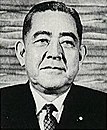From Wikipedia, the free encyclopedia
Election for the Japanese House of Councillors held in 1971
1971 Japanese House of Councillors election|
|
|
|
|
First party
|
Second party
|
Third party
|
|
|

|

|

|
| Leader
|
Eisaku Satō
|
Tomomi Narita
|
Yoshikatsu Takeiri
|
| Party
|
Liberal Democratic
|
Socialist
|
Kōmeitō
|
| Seats after
|
134
|
66
|
23
|
| Seat change
|
 3 3
|
 1 1
|
 1 1
|
| Popular vote
|
17,759,395
|
8,494,264
|
5,626,293
|
| Percentage
|
44.5%
|
21.3%
|
14.1%
|
| Swing
|
 2.2% 2.2%
|
 2.5% 2.5%
|
 1.4% 1.4%
|
|
|
|
Fourth party
|
Fifth party
|
|
|

|

|
| Leader
|
Kasuga Ikkō
|
Kenji Miyamoto
|
| Party
|
Democratic Socialist
|
Communist
|
| Seats after
|
13
|
10
|
| Seat change
|
 3 3
|
 3 3
|
| Popular vote
|
2,441,509
|
3,219,307
|
| Percentage
|
6.1%
|
8.1%
|
| Swing
|
 0.1% 0.1%
|
 3.1% 3.1%
|
|
|
House of Councillors elections were held in Japan on 27 June 1971,[1] electing half the seats in the House. The Liberal Democratic Party won the most seats.
 |
|---|
| Party | National | Constituency | Seats |
|---|
| Votes | % | Seats | Votes | % | Seats | Not up | Won | Total
after | +/– |
|---|
| Liberal Democratic Party | 17,759,395 | 44.47 | 21 | 17,727,263 | 43.95 | 41 | 72 | 62 | 134 | –3 |
| Japan Socialist Party | 8,494,264 | 21.27 | 11 | 12,597,644 | 31.24 | 28 | 27 | 39 | 66 | +1 |
| Komeitō | 5,626,293 | 14.09 | 8 | 1,391,855 | 3.45 | 2 | 13 | 10 | 23 | –1 |
| Japanese Communist Party | 3,219,307 | 8.06 | 5 | 4,878,570 | 12.10 | 1 | 4 | 6 | 10 | +3 |
| Democratic Socialist Party | 2,441,509 | 6.11 | 4 | 1,919,643 | 4.76 | 2 | 7 | 6 | 13 | +3 |
| Other parties | 48,300 | 0.12 | 0 | 74,739 | 0.19 | 0 | 0 | 0 | 0 | 0 |
| Independents | 2,342,517 | 5.87 | 1 | 1,741,201 | 4.32 | 1 | 3 | 2 | 5 | –2 |
| Total | 39,931,585 | 100.00 | 50 | 40,330,915 | 100.00 | 75 | 126 | 125 | 251 | +1 |
|
| Valid votes | 39,931,585 | 94.71 | | 40,330,915 | 95.65 | | |
|---|
| Invalid/blank votes | 2,229,158 | 5.29 | | 1,833,100 | 4.35 | | |
|---|
| Total votes | 42,160,743 | 100.00 | | 42,164,015 | 100.00 | | |
|---|
| Registered voters/turnout | 71,177,667 | 59.23 | | 71,177,667 | 59.24 | | |
|---|
| Source: Ministry of Internal Affairs and Communications,[1][2] National Diet |







